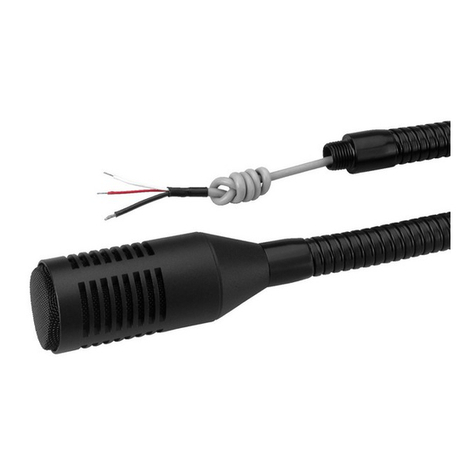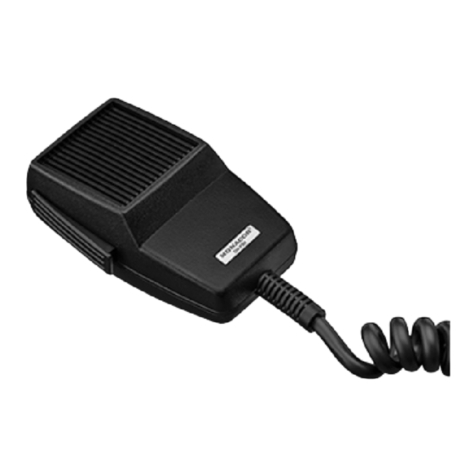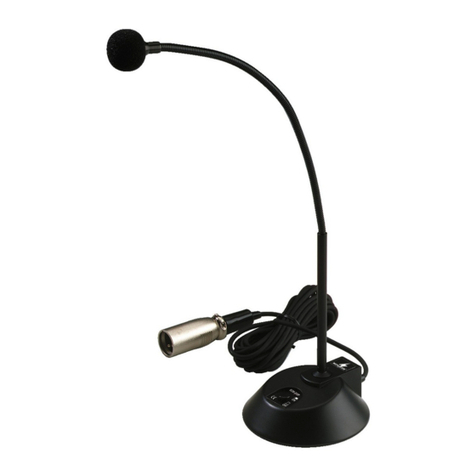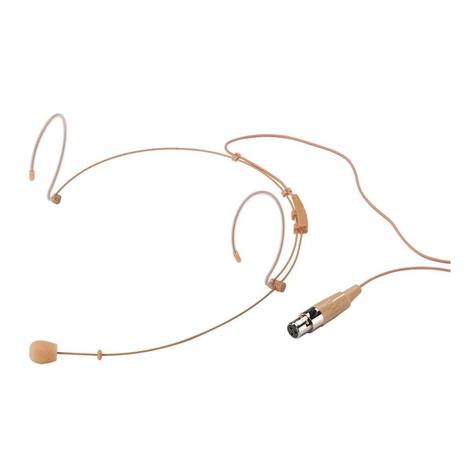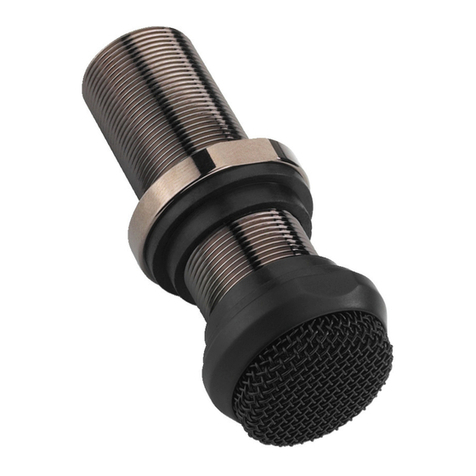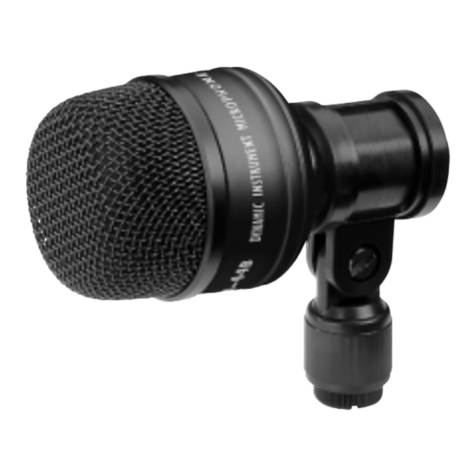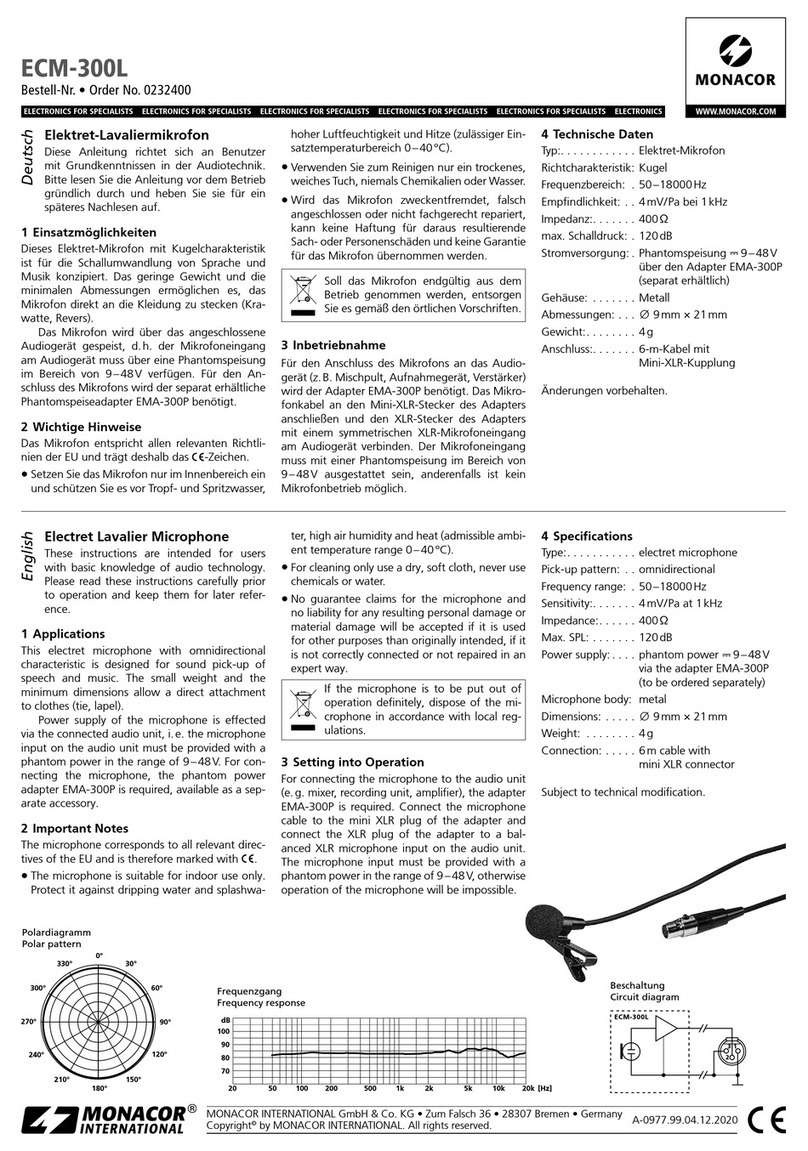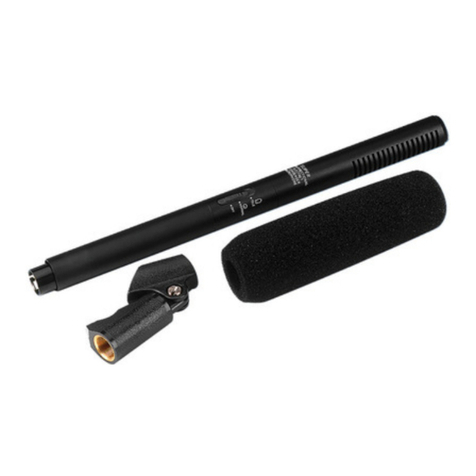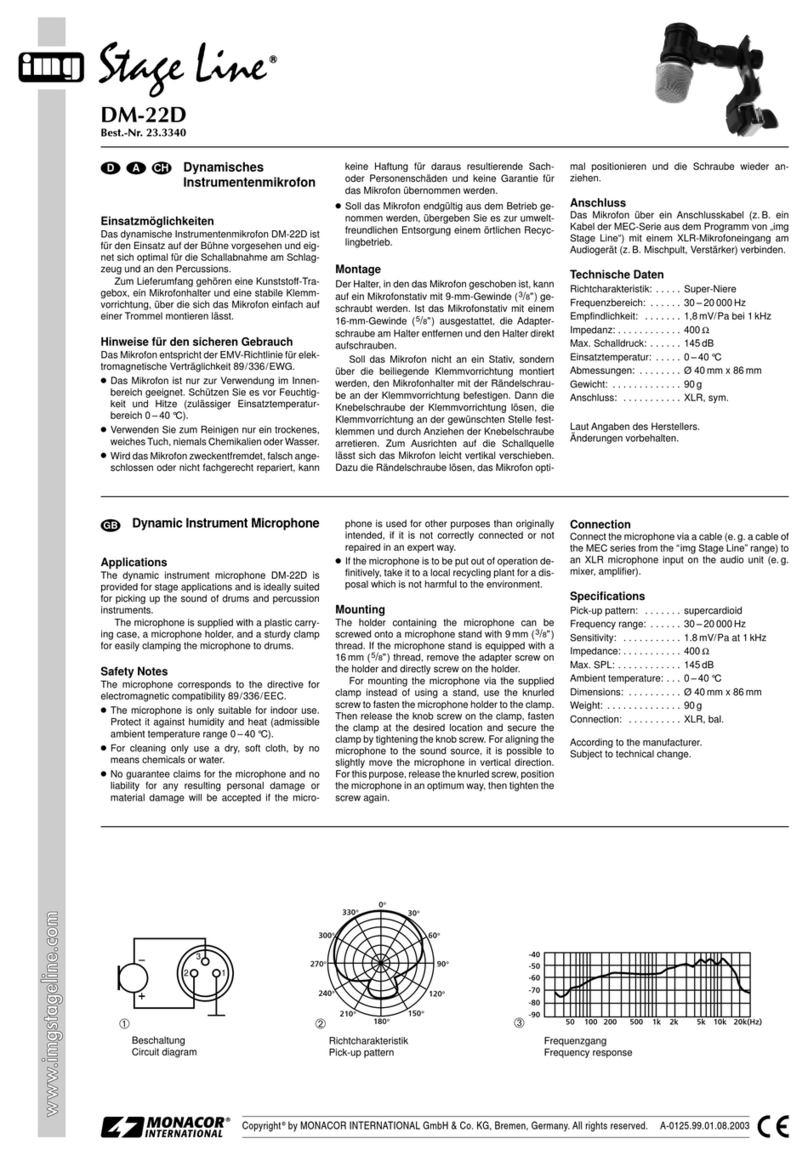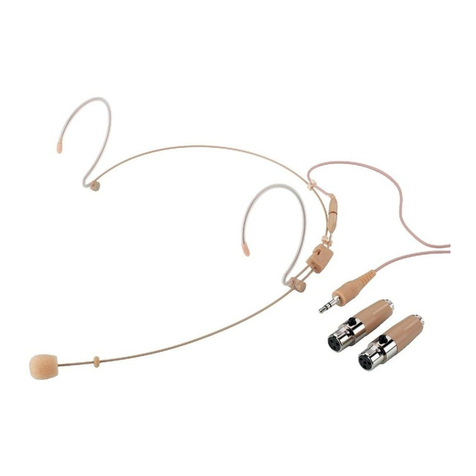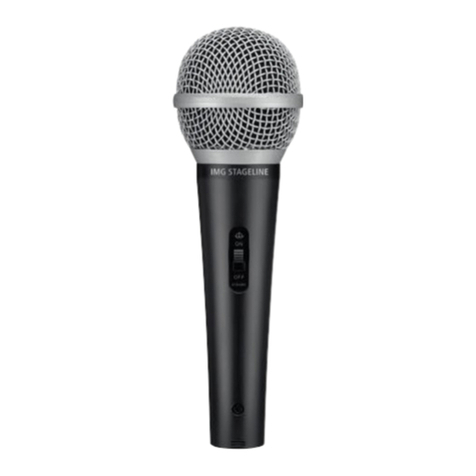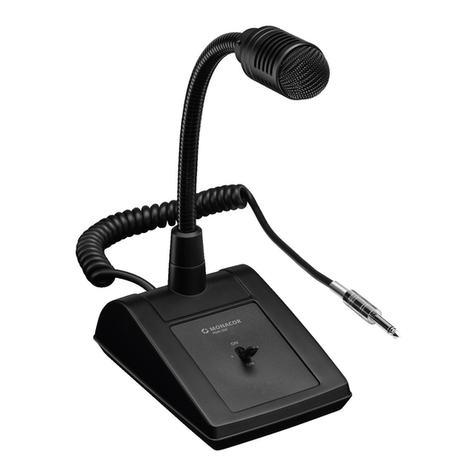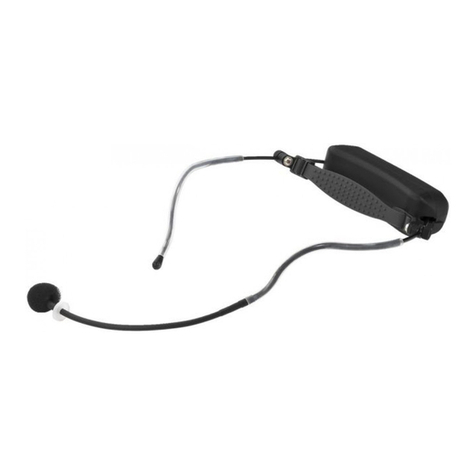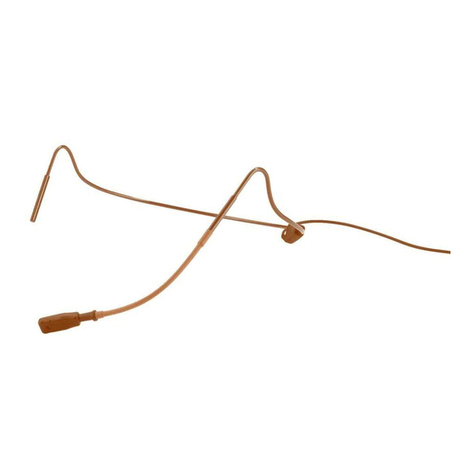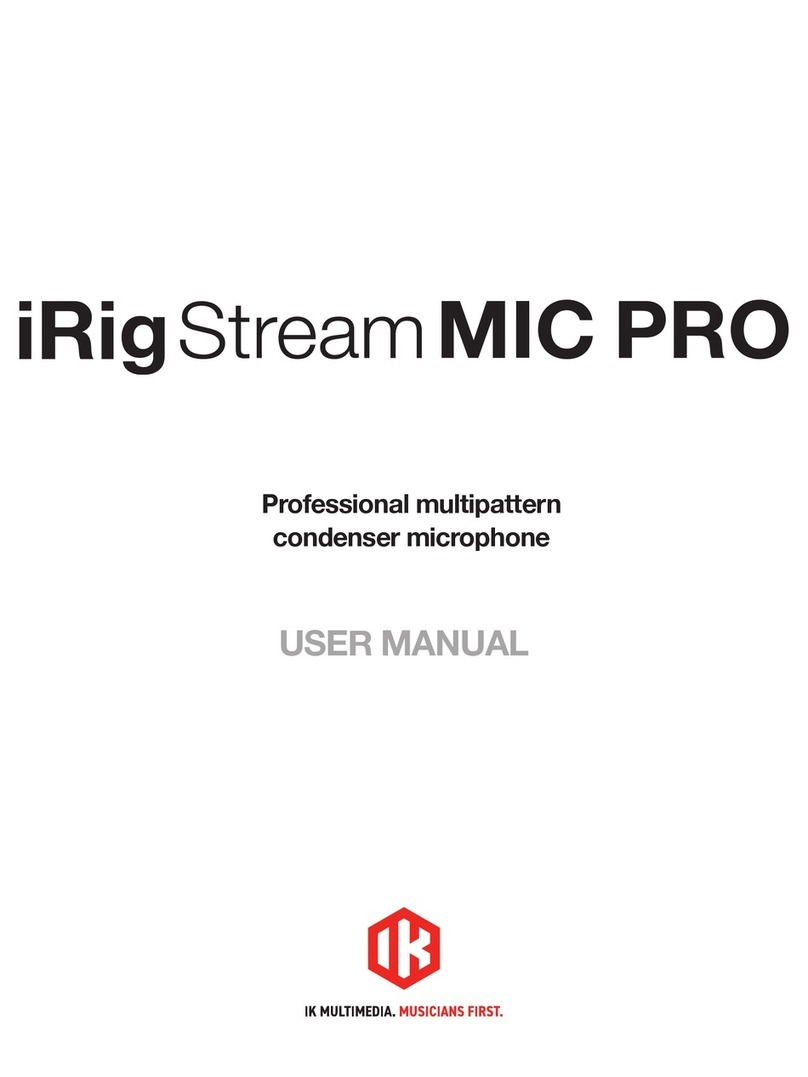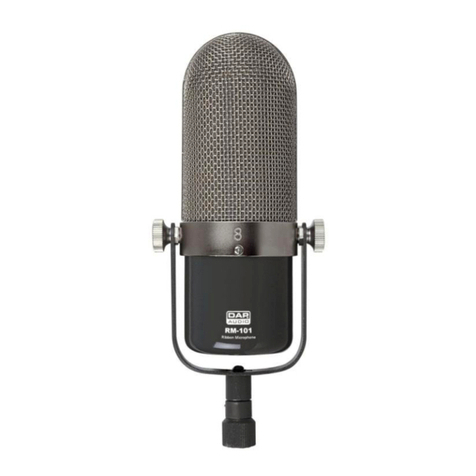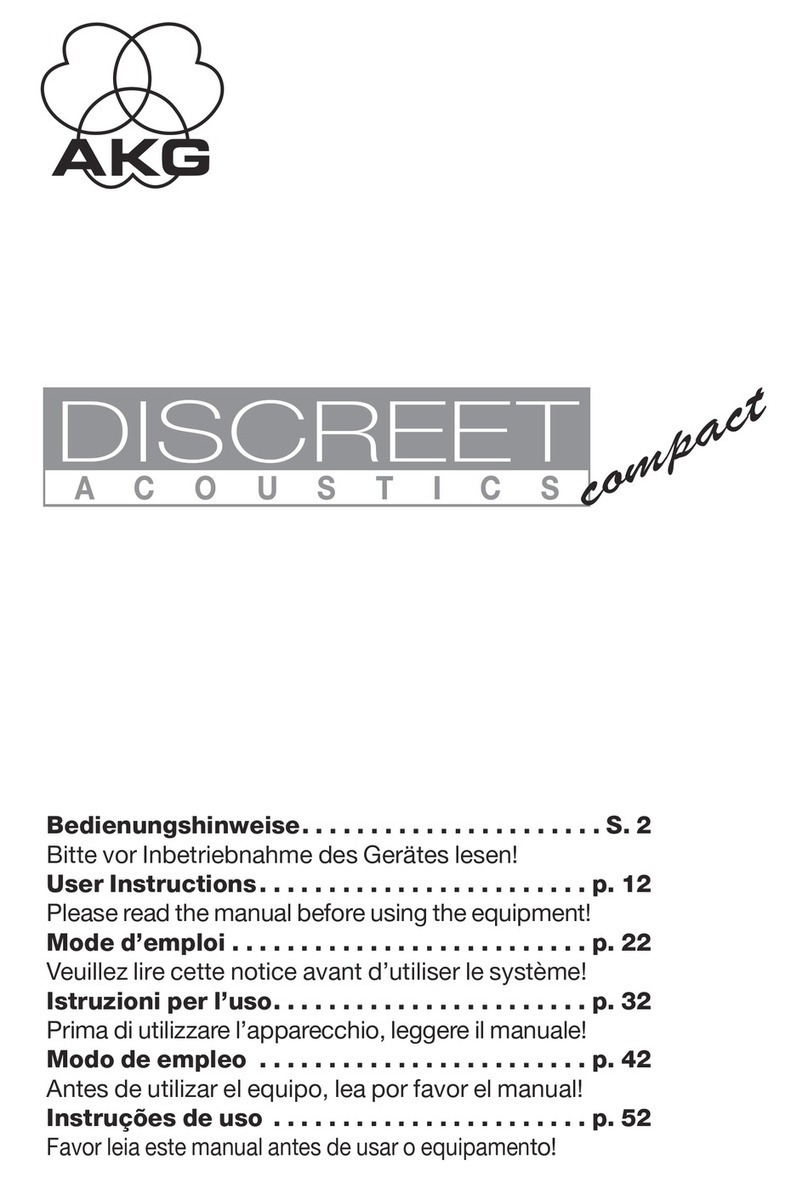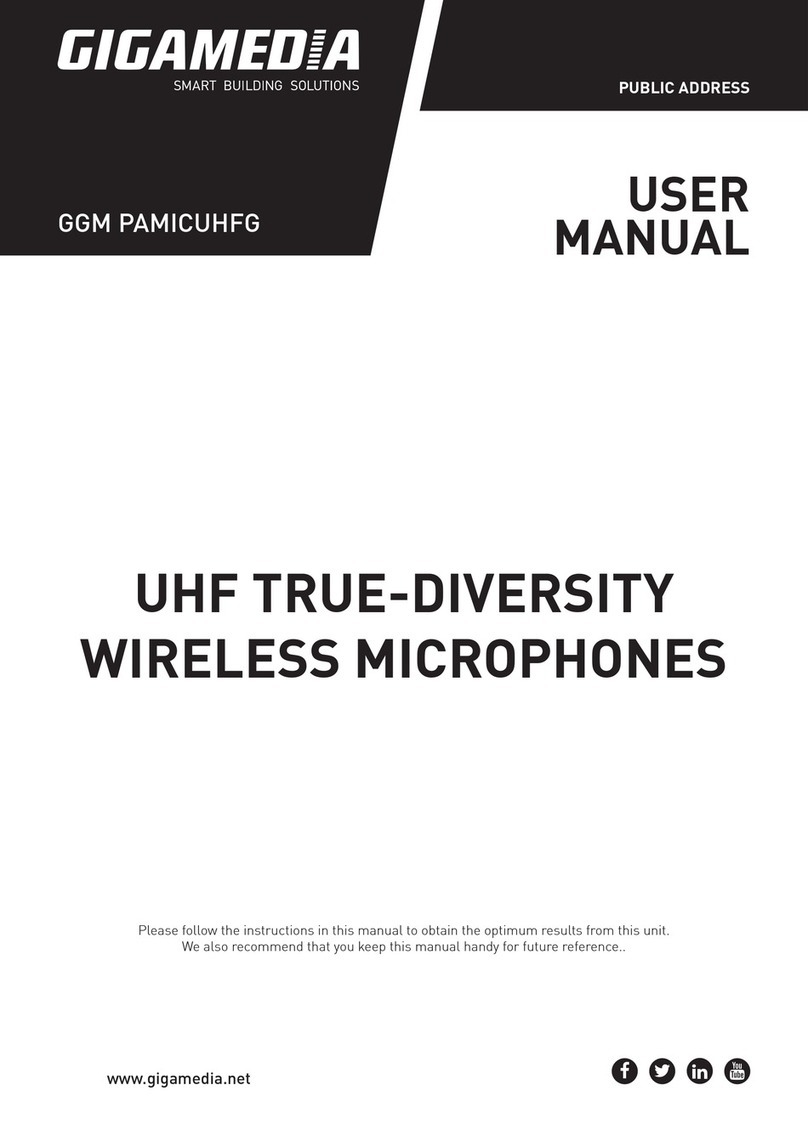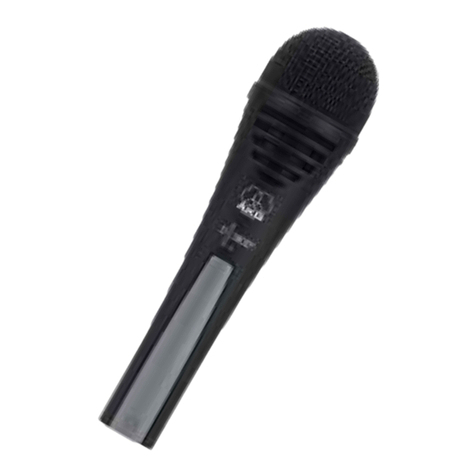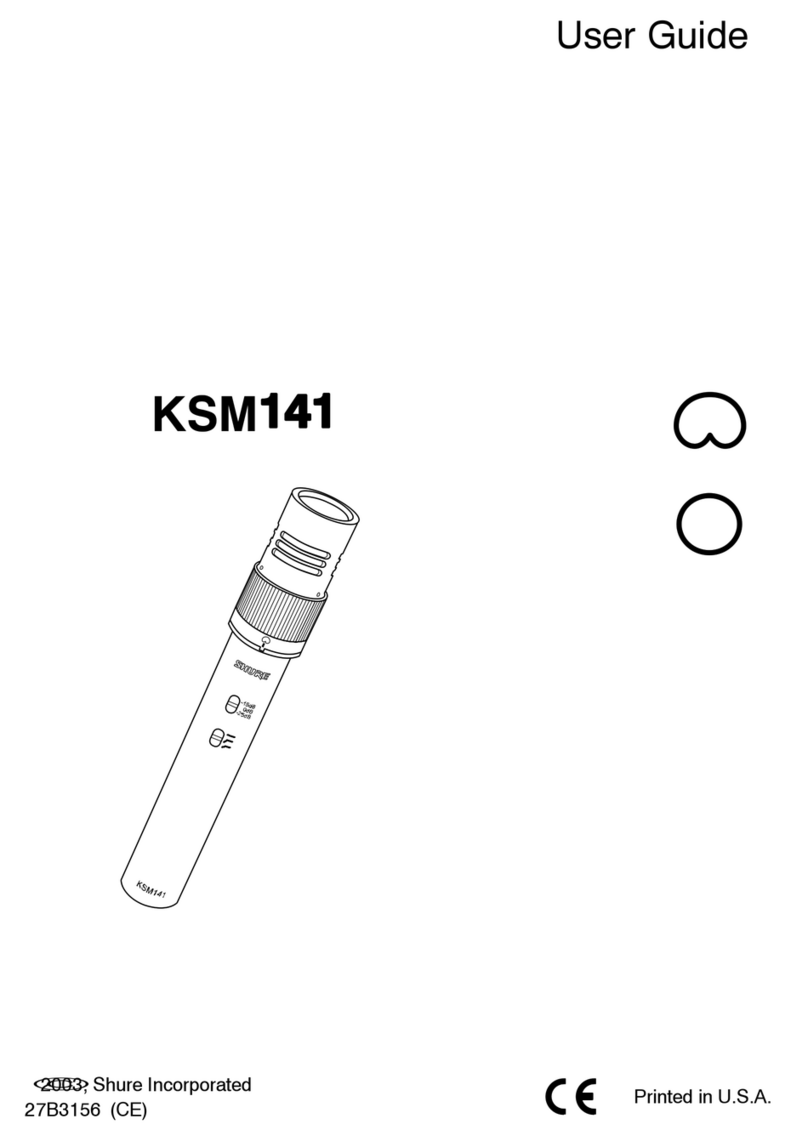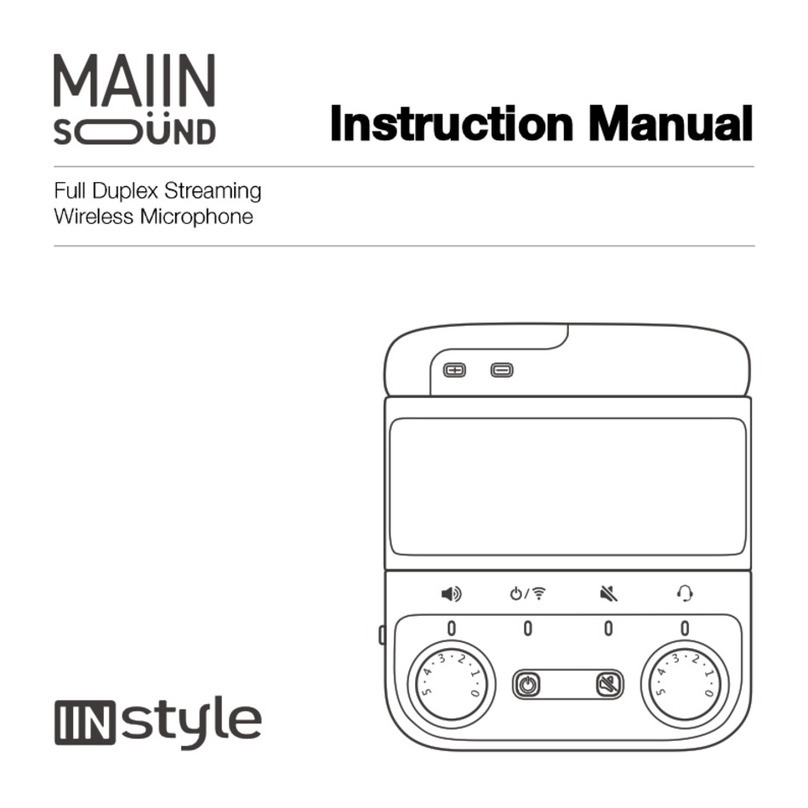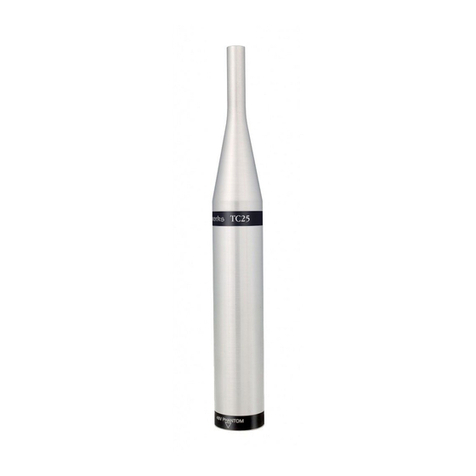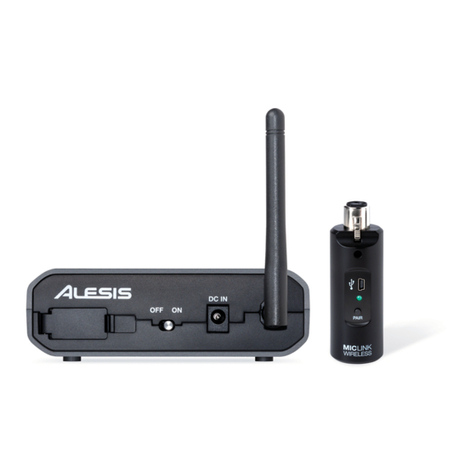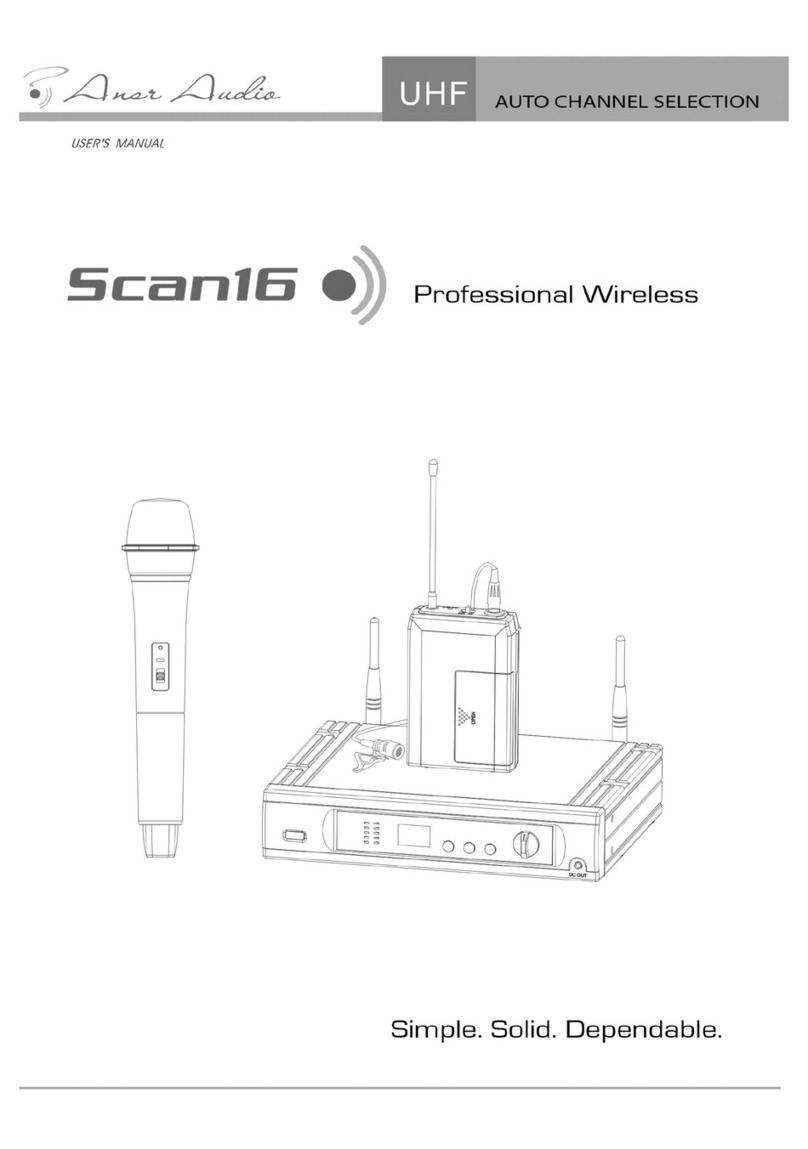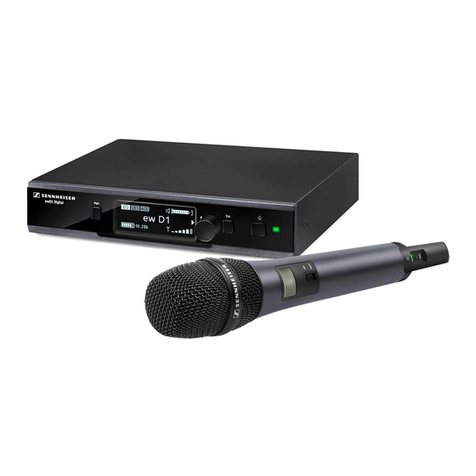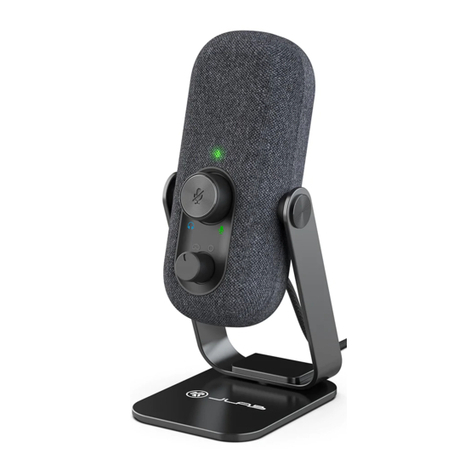Microphone électret
de mesure
Veuillez lire cette notice dʼutilisation avec atten-
tion avant le fonctionnement et conservez-la
pour pouvoir vous y reporter ultérieurement.
1 Possibilités dʼutilisation
Le microphone ECM-40 a une réponse en fré-
quence très linéaire et est donc particulièrement
adapté pour des mesures, par exemple de
haut-parleurs, dʼinstallations dʼamplificateurs et
de lʼacoustique des pièces. Grâce à ses très
bonnes propriétés, il peut être utilisé également
pour des enregistrements et diffusions de mu-
sique de haute qualité.
Le microphone est alimenté via lʼappareil
audio relié, cʼest-à-dire que lʼentrée micro sur
lʼappareil audio doit avoir une alimentation fan-
tôme (12 – 48 V ) ou il faut insérer une alimen-
tation fantôme.
2 Conseils importants dʼutilisation
Le microphone répond à toutes les directives né-
cessaires de lʼUnion européenne et porte donc
le symbole .
GLe microphone nʼest conçu que pour une uti-
lisation en intérieur. Protégez-le des écla-
boussures, de tout type de projections dʼeau,
ECM -40
Bestellnummer 23.2230
dʼune humidité dʼair élevée et de la chaleur
(température ambiante admissible 0 – 40 °C).
GPour le nettoyage, utilisez un chiffon sec et
doux, en aucun cas de produits chimiques ou
dʼeau.
GNous déclinons toute responsabilité en cas de
dommages corporels ou matériels résultants
si le microphone est utilisé dans un but autre
que celui pour lequel il a été conçu, sʼil nʼest
pas correctement branché ou nʼest pas réparé
par une personne habilitée ; en outre, tout
droit à la garantie deviendrait caduque.
3 Fonctionnement
1) Positionnez le microphone de manière opti-
male, p. ex. via la pince micro MH-99/SW et
un pied.
2) Reliez le microphone via le cordon livré à une
entrée micro XLR symétrique (par exemple
appareil de mesure, table de mixage, amplifi-
cateur). Lʼentrée micro doit avoir une alimen-
tation fantôme (12 – 48 V ) sinon, il faut in-
Lorsque le microphone est définitive-
ment retiré du service, vous devez le
déposer dans une usine de recyclage
de proximité pour contribuer à son éli-
mination non polluante.
sérer une alimentation fantôme (par exemple
EMA-3 ou EMA-200 de “img Stage Line”).
4 Caractéristiques techniques
Type : . . . . . . . . . . . . microphone électret
Caractéristique : . . . . omnidirectionnel
Bande passante : . . . 30 – 18 000 Hz, ±1 dB
Sensibilité : . . . . . . . . 5,6 mV/Pa à 1 kHz
Impédance : . . . . . . . 500 Ω
Pression sonore
maximale : . . . . . . . . 120 dB
Rapport signal/bruit : > 60 dB
Alimentation : . . . . . . alimentation fantôme
12 – 48 V
Température fonc. : . 0 – 40 °C
Dimensions : . . . . . . ∅13/19 mm × 158 mm
Poids : . . . . . . . . . . . 50 g
Branchement : . . . . . XLR, sym.
Cordon de
branchement : . . . . . cordon Low Noise, 6 m
Tout droit de modification réservé.
Microfono electret
per misurazioni
Vi preghiamo di leggere attentamente le presenti
istruzioni prima dellʻuso e di conservarle per un
uso futuro.
1 Possibilità dʼimpiego
Il microfono ECM-40 possiede una risposta in
frequenza molto lineare e perciò si appresta in
modo particolare per misurazioni, p. es. di alto-
parlanti, impianti dʼamplificazione e acustica am-
bientale. Grazie alle ottime caratteristiche può
essere utilizzato anche per riprese e trasmissioni
di musica di alta qualità.
Il microfono è alimentato tramite lʼapparecchio
audio collegato; lʼingresso per microfono del-
lʼapparecchio audio deve pertanto disporre di
unʼalimentazione phantom (12 – 48 V ) oppure
si deve inserire un alimentatore phantom.
2 Avvertenze importanti per lʼuso
Il microfono è conforme a tutte le direttive rile-
vanti dellʼUE e pertanto porta la sigla .
GUsare il microfono solo allʼinterno di locali.
Proteggerlo dallʼacqua gocciolante e dagli
spruzzi dʼacqua, da alta umidità dellʼaria e dal
calore (temperatura dʼimpiego ammessa fra
0 e 40 °C).
GPer la pulizia usare solo un panno morbido,
asciutto; non impiegare in nessun caso acqua
o prodotti chimici.
GNel caso dʼuso improprio, di collegamenti sba-
gliati o di riparazione non a regola dʼarte del
microfono, non si assume nessuna responsa-
bilità per eventuali danni consequenziali a
persone o a cose e non si assume nessuna
garanzia per il microfono.
3 Messa in funzione
1) Collocare il microfono in modo ottimale, per
esempio con lʼaiuto del supporto per micro-
fono MH-99/SW e di uno stativo.
2) Collegare il microfono con un ingresso bilan-
ciato per microfoni (p. es. dispositivo di misu-
razioni, mixer, amplificatore), servendosi del
cavo di collegamento in dotazione. Lʼingresso
microfono deve essere equipaggiato con
unʼalimentazione phantom (12 – 48 V ), altri-
menti occorre inserire un alimentatore phan-
tom (p. es. EMA-3 o EMA-200 di “img Stage
Line”).
Se si desidera eliminare il microfono
definitivamente, consegnarlo per lo
smaltimento ad unʼistituzione locale per
il riciclaggio
4 Dati tecnici
Tipo: . . . . . . . . . . . . . microfono electret
Caratteristica
direzionale: . . . . . . . . onnidirezionale
Gamma di frequenze: 30 – 18 000 Hz, ±1 dB
Sensibilità: . . . . . . . . 5,6 mV/Pa con 1 kHz
Impedenza: . . . . . . . 500 Ω
Pressione
sonora max.: . . . . . . 120 dB
Rapporto S/R: . . . . . > 60 dB
Alimentazione: . . . . . alimentazione phantom
12 – 48 V
Temperatura
dʼesercizio: . . . . . . . . 0 – 40 °C
Dimensioni: . . . . . . . ∅13/19 mm × 158 mm
Peso: . . . . . . . . . . . . 50 g
Contatto: . . . . . . . . . . XLR, bil.
Cavo di collegamento: cavo low-noise, 6 m
Con riserva di modifiche tecniche.
®
MONACOR INTERNATIONAL GmbH & Co. KG
•
Zum Falsch 36
•
28307 Bremen
•
Germany
Copyright
©
by MONACOR INTERNATIONAL. All rights reserved. A-0992.99.02.01.2012
wwwwww..iimmggssttaaggeelliinnee..ccoomm
F
I
B CH
